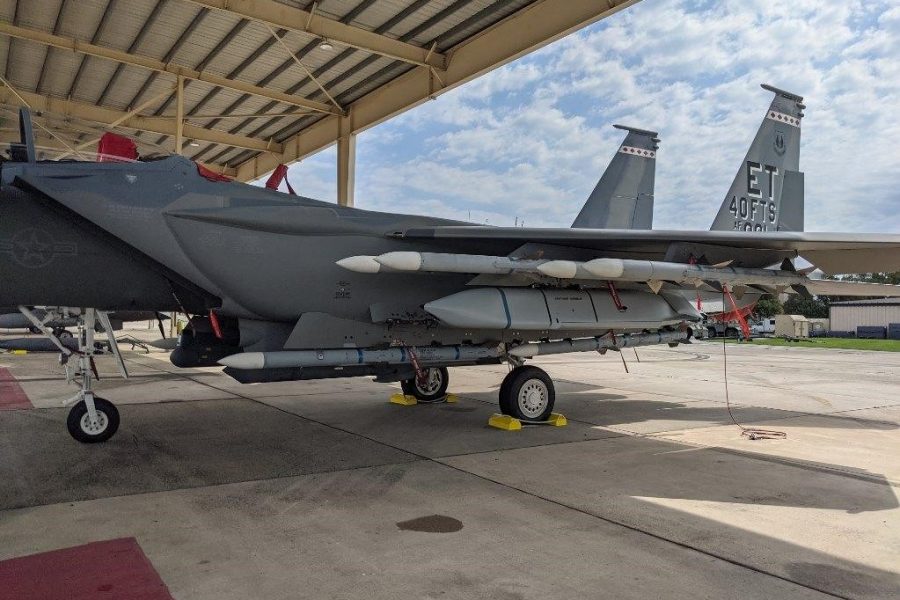RTX’s Raytheon unit was able to “significantly” extend the range of the AIM-120 Advanced Medium-Range Air-to-Air Missile using mostly software changes in experimental tests last year, expanding the reach and lethality of the standard U.S. dogfighting weapon, company officials said Sept. 15.
The improvements, already included with rounds coming off the production line, should make U.S. fighters more competitive with Chinese aircraft equipped with that country’s longer-ranged PL-15 and later weapons. What’s more, officials say still more flight time may yet be squeezed out of the AMRAAM.
The Air Force and RTX conducted the tests with AIM-120D missiles launched from an F-22 at Eglin Air Force Base, Fla., in the fall of 2024, Raytheon officials said at a press event ahead of AFA’s Air, Space and Cyber conference next week at National Harbor, Md.
“This is the longest known shot of an AMRAAM by a fifth-generation fighter,” a Raytheon spokesperson said. The tests were not revealed until now because the company only just received Air Force approval to discuss them, she said.
The AMRAAM is integrated on 14 different platforms in 43 countries and can also be used in the NASAMS air defense system.
The exact range of the AMRAAM is operationally sensitive but is generally regarded to be around 80 miles with the D3 variant. Raytheon officials declined to characterize exactly how much farther the tests showed the AMRAAM could go, referring such questions to the Air Force, which was not able to offer a comment by press time. The Chinese PL-15 is said to have a range of up to 190 miles. The export version, the PL-15E, has a range of about 90 miles.
“Modern electronics” allowed Raytheon to make the guidance section on the D model as part of a Form, Fit, and Function Refresh (F3R) update. That “allowed us to have a little bit bigger engine from the propulsion side,” said Jon Norman, Raytheon vice president of requirements and capabilities. But the main improvement, he said, is in a more efficient battery and software that takes advantage of the higher altitudes and speeds at which fifth-generation F-22 and F-35 fighters can launch missiles. The AMRAAM uses a solid rocket motor.
Norman said engineers were able to “extend the time of flight” of the AMRAAM, thus expanding its range.
“We were able to fly it much longer,” he said. “The propulsion and aerodynamic properties off the missile … in that F3R variant … always had the capability to go further. We just had not been able to take advantage of it. So at this point, it’s the way we’re flying it. It’s flying higher and longer. We can fly at a much faster speed at release, which just improves the performance of the missile.” A company spokesperson said this is called “fly-out optimization.”
The improvements will allow “pilots the ability to take shots that are further than they ever imagined before,” Norman said. The new software will also give the AMRAAM capability “against a wider variety of threats and increase the probability … targeting that threat,” he said.
Norman also said the company will continue to work with the Air Force to squeeze more range out of the AIM-120, asserting “That missile is just going to get better.”
There’s “still a lot more work to do to improve it even further with software. We can do this with a Software Improvement Program, and we’ll continue to optimize the way that missile flies to get the max capability out of the aerodynamics of the weapon itself,” he said.
Because the software changes are transparent to the pilot, no additional training is needed to use the updated weapon, he added.
Raytheon got a $760 million Air Force contract on Sept. 9 to conduct “mitigation of obsolescence” of production, sustainment and development on AMRAAM. That followed a record $3.5 billion contract in July for production of AMRAAM lots 39 and 40, along with spares and support. That contract runs through 2031, but the exact number of missiles to be procured is considered sensitive for the Air Force and proprietary for Raytheon. Foreign Military Sales to 19 countries are also included in that contract.
“AMRAAMs coming of the production line today have the range capability demonstrated” in the long-range test, the spokesperson said.
Taking an iterative approach to improvements and upgrades with AMRAAM puts enhanced capabilities in the hands of operators “much, much faster, without all the added cost of integrating a new weapon,” Norman said, noting that a sustainment and support enterprise for the missile is well established.
Production rates are also ramping up, he said.
“We’ve invested significantly in the production to do this more efficiently,” he said. “We’ve invested in new test equipment and the way we design and assemble these weapons, so that we can produce these faster. Just this year, our production has increased … by almost 50 percent, and it’s just going to continue. We’re working very, very closely with the Department of War and we’re looking at new ways of doing business. We’re looking at new ways of testing, all with the end in mind of accelerating production and throughput.”
While Raytheon touted its progress on AMRAAM, the Air Force is in flight testing and possibly early operational status with the classified Lockheed Martin AIM-260 Joint Advanced Tactical Missile, AMRAAM’s intended replacement. That weapon is said to have a range of about 125 miles or more.
Asked if the new improvements make the AMRAAM competitive with JATM, the spokesperson said “AMRAAM is widely considered the premiere air-to-air missile, and we are continually improving it to meet current and future threats.”
Norman also said Raytheon is looking to extend the range of its Stormbreaker/Small Diameter Bomb II. He said an “air-breathing propulsion solution” will be integrated with the ground-attack weapon, a change that will “greatly increase the range.” A flight demonstration is to take place in early 2026.


